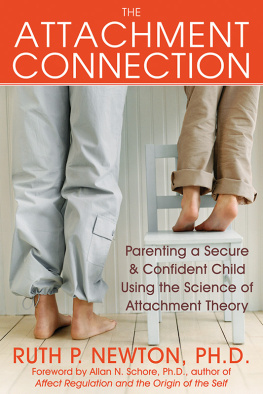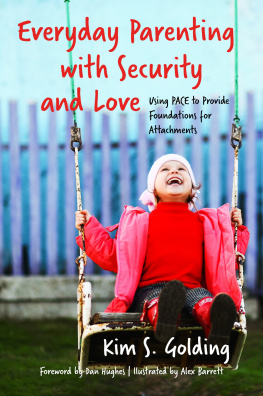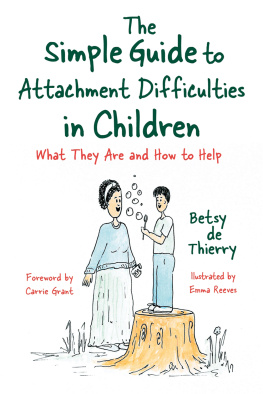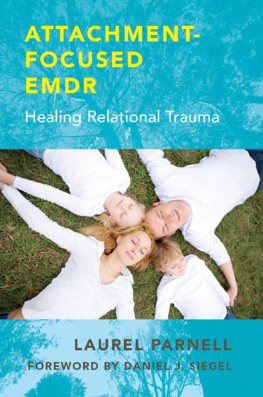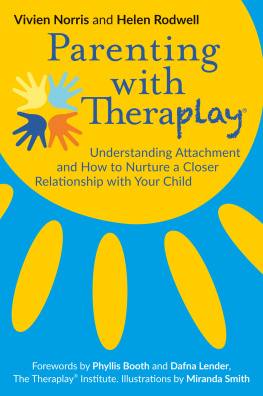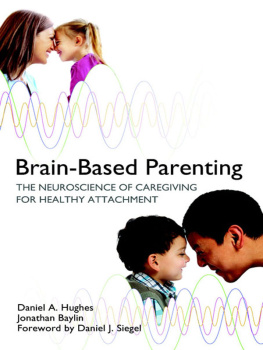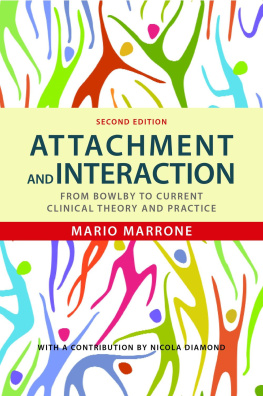ACKNOWLEDGMENTS
Numerous researchers have been working for over 50 years to help us in our understanding of the central role of attachment and intersubjectivity in human development. They are far too many to acknowledge and I will mention only a few who have been most instrumental in my developing knowledge. They are Alan Sroufe, Dante Chichetti, Mary Dozier, John Bowlby, and Colwyn Trevarthen. I am also most grateful to two theorists who have taken this research, along with research in other fields, and have begun to suggest connections in many applied fields. They are Allan Schore and Dan Siegel, who have supported my own work at many times and in many ways.
I wish to also acknowledge how indebted I am to my friends, who have enabled me to understand attachment and intersubjectivity in a way that I could never comprehend simply from reading books or attending conferences. Through this work I have become friends with colleagues throughout the US, Canada, UK, Ireland, and Australia. Who they are and what they bring to their work continues to influence my own professional and personal development.
My parents and siblings have been part of my safety and intersubjective experience over my whole lifes journey. My three daughters have taught meand continue to teach meat least as much as I have taught them. Most recently I have discovered these realities from the perspective of a grandfather. Alice Rose does not yet know it, but she too is teaching me, possibly most of all at this time of my life. And so, this book is dedicated to her.
REFERENCES
Cassidy, J. (1999). The nature of the childs ties. In J. Cassidy & P. Shaver (Eds.), Handbook of attachment (pp. 320). New York: Guilford.
Cassidy, J., & Shaver, P. R. (Eds.). (1999). Handbook of attachment . New York: Guilford.
Greenberg, M. T. (1999). Attachment and psychopathology in childhood. In J. Cassidy & P. Shaver (Eds.), Handbook of attachment (pp. 469496). New York: Guilford.
Grossmann, K. E., Grossmann, K., & Waters, E. (Eds.). (2005). Attachment from infancy to adulthood: The major longitudinal studies . New York: Guilford.
Grossmann, K. E., Grossmann, K., & Zimmermann, P. (1999). A wider view of attachment and exploration: Stability and change during the years of immaturity. In J. Cassidy & P. Shaver (Eds.), Handbook of attachment (pp. 760786). New York: Guilford.
Hughes, D. A. (2006). Building the bonds of attachment (2nd ed.). New York: Jason Aronson.
Hughes, D. A. (2007). Attachment-focused family therapy . New York: Norton.
Kabat-Zinn, M. & Kabat-Zinn, J. (1997). Everyday blessing: The inner work of mindful parenting . New York: Hyperion.
Lyons-Ruth, K., & Jacobvitz, D. (1999). Attachment disorganization: Unresolved loss, relational violence, and lapses in behavioral and attentional strategies. In J. Cassidy & P. Shaver (Eds.), Handbook of attachment (pp. 520554). New York: Guilford.
Schore, A. N. (2000). Attachment and the regulation of the right brain. Attachment and Human Development , , 2347.
Schore, A. N. (2003). Affect regulation and the repair of the self . New York: Norton.
Schore, A. N. (2005). Attachment, self regulation, and the developing right brain: Linking developmental neuroscience to pediatrics. Pediatrics in Review , , 204211.
Siegel, D. J. (1999). The developing mind. New York: Guilford.
Siegel, D. J. (2007). The mindful brain. New York: Norton.
Siegel, D. J., & Hartzell, M. (2003). Parenting from the inside out . New York: Jeremy P. Tarcher/Putnam.
Sroufe, L. A., Egeland, B., Carlson, E., & Collins, W. A. (2005). The development of the person . New York: Guilford.
Tangney, J., & Dearing, R. (2002). Shame and guilt . New York: Guilford.
Trevarthen, C. (2001). Intrinsic motives for companionship in understanding: Their origin, development, and significance for infant mental health. Infant Mental Health Journal, 22 , 95131.
Trevarthen, C., & Aitken, K. J. (2001). Infant intersubjectivity: Research, theory, and clinical applications. Journal of Child Psychology and Psychiatry, 42 , 348.
CHAPTER ONE
What Is Attachment and How Does Parenting Affect It?
I n understanding the nature of the parent-child relationship and the pivotal role of attachment, we are able to see its impact on a childs emotional, cognitive, social, communicative, and even physiological and neurological development. Similarly, although possibly less obviously, we are also able to understand how being a parent affects the parents development as well.
Some Background on Attachment
The founding parents of attachment theory and research are Mary Ainsworth and John Bowlby. They considered attachment to be characterized by six components, five of which were shared by other affectional bonds. The attachment relationship is:
- Persistent or ongoing, not temporary
- Directed toward a specific person
- Emotionally significant
- Directed toward maintaining contact with the other
- Characterized by distress during periods of involuntary separation
- Characterized by seeking security and comfort (This component is considered to be uniquely necessary for attachment [Cassidy, 1999, p. 12]).
While these six qualities might seem like common sense, they need to be stated because they are often taken for granted, and in the process may not influence child rearing as much as one might hope. Families are increasingly characterized by change, in the form of moves and loss of regular contact with extended family and friends, as well as divorce and blended families. With both parents often working long hours outside the home, the amount of time they are engaged in reciprocal and enjoyable activities with their children is likely to be less and the separations from their children longer. As the pressures on the parent-child relationship increase, the pressure to minimize its importance and focus on behavior also increases. Such behavioral focuses are appealing in the ease of application but often disappointing in their results.
It is also interesting to ask why these six qualities in relationships are important for human development. Why does the child need to have unique parents with whom to relate over time, rather than having parents in the present interchangeable with different ones in the future? Why should the contact be repetitive and lead to safety and comfort when together, along with distress during periods of separations? Whyand just as important, howdo our attachment figures become the source of our learning and discoveries about ourselves and our world? In answering these questions, we get a sense of how a childs development is intimately interwoven with the nature of his relationship with his parents.
A relationship that is characterized by attachment security facilitates many areas of development in the child. These include physiological and emotional regulation, self-reliance, resilience, social competence with peers, empathy for others, symbolic play, problem solving, intellectual development, communication and language skills, and self-integration and self-worth. The effects of attachment security on these areas of development are evident at the preschool stage, but also throughout childhood, adolescence, and into adulthood, as long as there were no significant disruptions in the security of the attachment relationships (Cassidy & Shaver, 1999; Grossman, Grossmann, & Waters, 2005; Sroufe, Egeland, Carlson, & Collins, 2005).
About two-thirds of all children manifest attachment security and are able to benefit from its positive influence on their development. The other third have attachments characterized by insecurity. The majority of children with insecure attachments still have organized patterns of attachment, though the patterns are limited in their benefit to the child and leave them vulnerable to some developmental challenges. By organized I mean that the child will manifest a fairly predictable series of responses to his attachment figures when he is in distress. In one pattern organized, but avoidant the child tends to minimize the importance of his parents in his development and overemphasizes his self-reliance skills. Failures and distress that might be managed and more easily reduced are more prevalent because such children avoid turning to their attachment figures when their engagement would be very beneficial. In the other pattern organized, but ambivalent the child overemphasizes his reliance on his parents and minimizes the need to develop his self-reliance skills. Such children often manage lifes difficulties poorly because they do not develop the self-reliance skills needed to manage situations when their parents are not present. In essence, the first group stresses independence at the expense of relationships and the second group stresses relationships at the expense of independence. Neither is able to find the balance between the two that the securely attached child and adult can. The research is very clear that securely attached children do not become dependent on others as adults. If you meet your childs need to feel safe, your child will develop excellent self-reliance skills and resiliency while still being able to rely on significant others when the situation calls for it.









